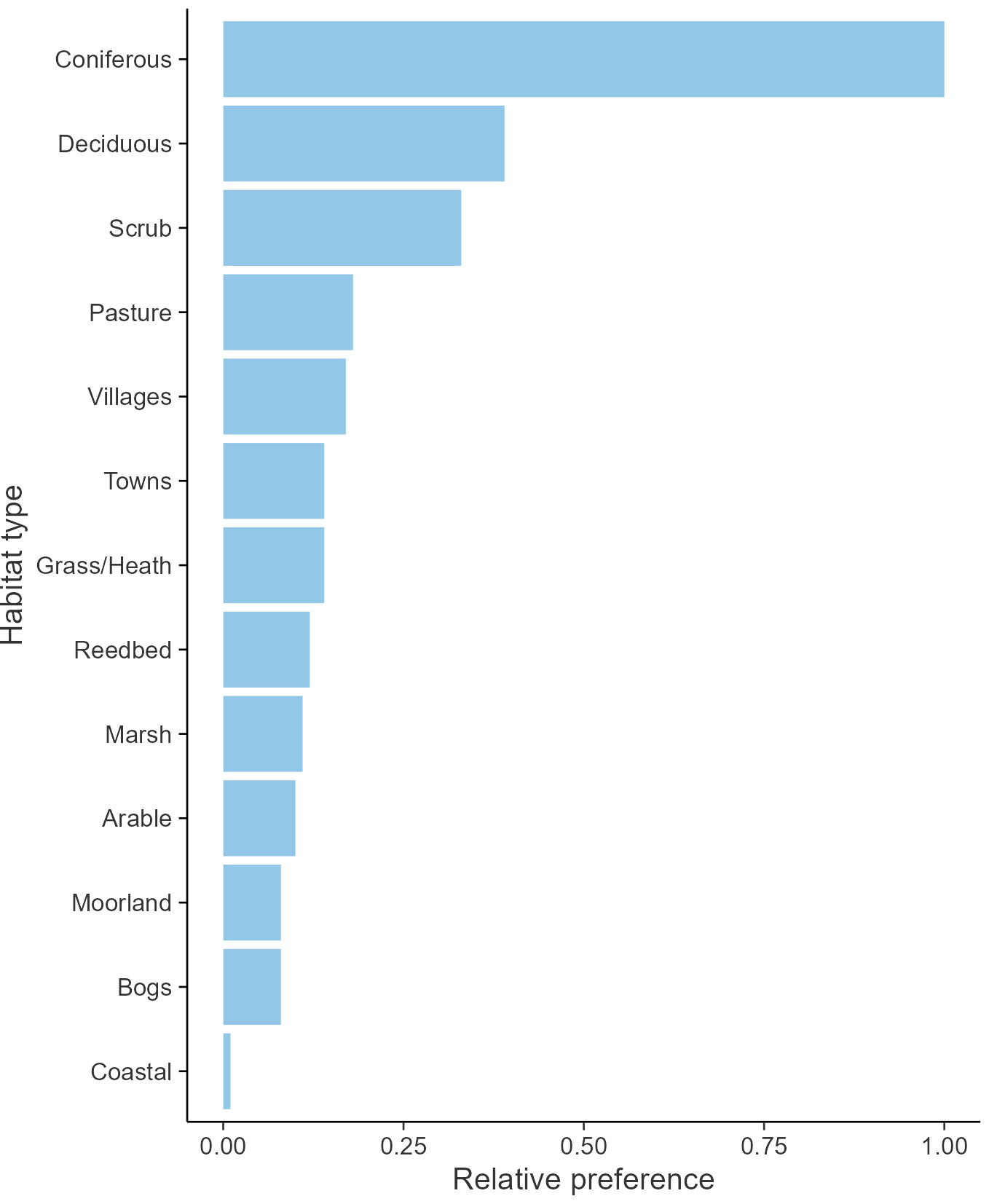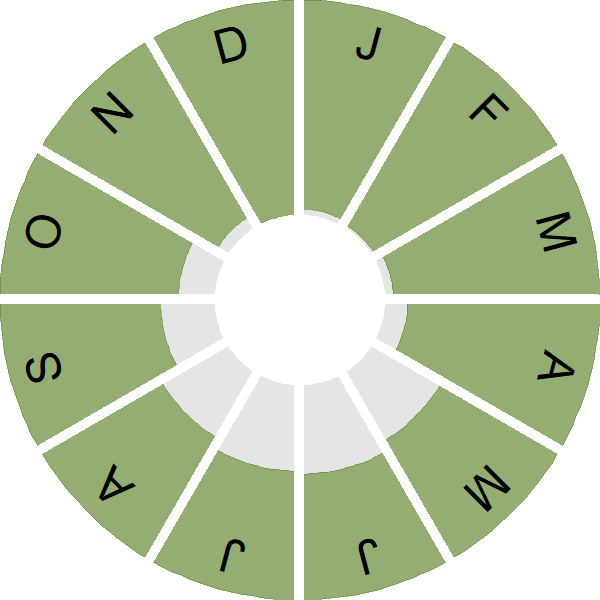Coal Tit

Introduction
Smaller than many other tits, Coal Tits show a preference for conifer forests, though they are also common garden visitors.
The wings and back are largely olive-grey, with pale wingbars. Birds have a black cap and bib, contrasting with white cheeks, and a distinctive white spot on the nape. The song is similar to Great Tit, with a bisyllabic rhythm, but more slurred and higher pitched. Two Coal Tit subspecies occur in Britain & Ireland, both of which differ from birds found in Continental Europe
Coal Tits spend the majority of their time hunting for spiders and insects in woodland, especially among conifers. They nest in tree hollows, but will also use nests boxes. They produce one or two broods each year. UK Coal Tit numbers increased in the mid-20th century and have been fairly stable since. They can be found in woodland throughout Britain & Ireland.
- Our Trends Explorer gives you the latest insight into how this species' population is changing.

Key Stats
Identification
ID Videos
This section features BTO training videos headlining this species, or featuring it as a potential confusion species.
#BirdSongBasics: Great Tit and Coal Tit
GBW: Coal Tit and Marsh Tit
Songs and Calls
Song:
Call:
Alarm call:
Begging call:
Other:
Status and Trends
Conservation Status
Population Change
While other common tit species have increased, the UK Coal Tit population has been rather stable since the mid 1970s, following earlier rapid increase. The ratios of Coal Tit to Blue and Great Tits caught for ringing have both shown a sustained increase since 1960 (Perrins 2003), however, although in these figures population change may be confounded to some degree with changes in behaviour among birds and bird ringers. The BBS map of change in relative density between 1994-96 and 2007-09 indicates that population change was fairly uniform across the UK over that period, but with stronger increases in Northern Ireland, the Scottish Borders and northeastern Scotland. However more recent BBS data show a subsequent shallow decrease in Scotland and perhaps also in Wales and Northern Ireland. The European trend is described as being a 'moderate decline'; however the trend graph suggests numbers have been broadly stable apart from a peak in the early 1990s, and the long-term change is calculated as +3% (PECBMS: PECBMS 2020a>).
Distribution
Coal Tits are most abundant in conifer plantations. Highest densities are recorded throughout Ireland, and in heavily forested areas in Scotland and Wales, and in localised pockets in England, particularly Thetford Forest and the New Forest. The most notable gaps in distribution occur on the highest ground in Scotland, the Northern Isles, some Hebridean islands and the Fens in eastern England.
Occupied 10-km squares in UK
or view it on Bird Atlas Mapstore.
or view it on Bird Atlas Mapstore.
European Distribution Map
Distribution Change
Modest range expansions and population increases have been linked to the spread of commercial softwood plantations and also the popularity of exotic evergreens in gardens.
Change in occupied 10-km squares in the UK
or view it on Bird Atlas Mapstore.
or view it on Bird Atlas Mapstore.
Seasonality
Coal Tit is recorded throughout the year.
Weekly pattern of occurrence
The graph shows when the species is present in the UK, with taller bars indicating a higher likelihood of encountering the species in appropriate regions and habitats.

Habitats
Breeding season habitats
Relative frequency by habitat
The graph shows the habitats occupied in the breeding season, with the most utilised habitats shown at the top. Bars of similar size indicate the species is equally likely to be recorded in those habitats.

Movement
Britain & Ireland movement
Foreign locations of birds ringed or recovered in Britain & Ireland
Dots show the foreign destinations of birds ringed in Britain & Ireland, and the origins of birds ringed overseas that were subsequently recaptured, resighted or found dead in Britain & Ireland. Dot colours indicate the time of year that the species was present at the location.
- Winter (Nov-Feb)
- Spring (Mar-Apr)
- Summer (May-Jul)
- Autumn (Aug-Oct)

European movements
EuroBirdPortal uses birdwatcher's records, such as those logged in BirdTrack to map the flows of birds as they arrive and depart Europe. See maps for this species here.
The Eurasian-African Migration Atlas shows movements of individual birds ringed or recovered in Europe. See maps for this species here.
Biology
Productivity and Nesting
Nesting timing
Egg measurements
Clutch Size
Survival and Longevity
Survival is shown as the proportion of birds surviving from one year to the next and is derived from bird ringing data. It can also be used to estimate how long birds typically live.
View number ringed each year in the Online Ringing Report.
lifespan
Survival of adults
Biometrics
Wing length and body weights are from live birds (source).
Wing length
Body weight
Ring Size
Classification, names and codes
Classification and Codes
- Order: Passeriformes
- Family: Paridae
- Scientific name: Periparus ater
- Authority: Linnaeus, 1758
- BTO 2-letter code: CT
- BTO 5-letter code: COATI
- Euring code number: 14610
Alternate species names
- Catalan: mallerenga petita
- Czech: sýkora uhelnícek
- Danish: Sortmejse
- Dutch: Zwarte Mees
- Estonian: musttihane
- Finnish: kuusitiainen
- French: Mésange noire
- Gaelic: Smutag
- German: Tannenmeise
- Hungarian: fenyvescinege
- Icelandic: Barrmeisa
- Irish: Meantán Dubh
- Italian: Cincia mora
- Latvian: meža zilite
- Lithuanian: juodoji zyle
- Norwegian: Svartmeis
- Polish: sosnówka
- Portuguese: chapim-carvoeiro
- Slovak: sýkorka uhliarka
- Slovenian: menišcek
- Spanish: Carbonero garrapinos
- Swedish: svartmes
- Welsh: Titw Penddu
Research
Causes of Change and Solutions
Causes of change
There is little good evidence available regarding the drivers of the breeding population change in this species in the UK.
Further information on causes of change
Information on the causes of change is sparse, though some effect of cold winters is evident in the 1960s and 1980s. Nest failure rate at the egg stage has declined in recent decades, and the laying date has advanced by almost two weeks, but there has been no change in nest productivity.
Information about conservation actions
The UK population has been relatively stable since the mid-1970s, hence the Coal Tit is not a species of concern and no conservation actions are currently required.
The drivers of change for this species are unknown and specific conservation actions that may benefit this species are uncertain. It may benefit from the increased provision of bird food in gardens and from other actions which support other woodland birds such as woodland management and the provision of nest boxes. However, the effect of these actions will not necessarily be positive for Coal Tits as they could also lead to increased Blue Tit and Great Tit populations, and hence greater levels of interspecific competition as these two species are both dominant over Coal Tits (Haftorn 1993).

